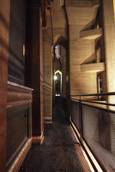ICONIC TURIN LANDMARK OPENS SECRET PATHWAYS
By Kate Carlisle
14 maggio, 19:45 (ANSA) - Turin, May 14 - Most monuments in Italy hold some
sort of superstitious sway over the city's inhabitants where
they are found.
Or at least a tad bit of mystery.
Students in the Tuscan city of Pisa run around its Leaning
Tower endlessly to guarantee good grades on exams.
Instead, in the Piedmont city of Turin, a ride to the top
of the landmark Mole Antonelliana and its towering ramparts is
shunned by students, whose peers advise them to avoid a climb on
the accessible panoramic terrace before university exams.
(ANSA) - Turin, May 14 - Most monuments in Italy hold some
sort of superstitious sway over the city's inhabitants where
they are found.
Or at least a tad bit of mystery.
Students in the Tuscan city of Pisa run around its Leaning
Tower endlessly to guarantee good grades on exams.
Instead, in the Piedmont city of Turin, a ride to the top
of the landmark Mole Antonelliana and its towering ramparts is
shunned by students, whose peers advise them to avoid a climb on
the accessible panoramic terrace before university exams.However, that ban has never included the rest of the building for the simple reason that for some 100 years, most of the structure's inner secrets have been closed to the public.
With the exception of employees of the Museum of Cinema located inside since 2000, and the occasional lucky worker, the inner workings of architect Alessandro Antonelli's Mole remain an unvisited mystery.
For the 150th anniversary of the Turin architectural triumph, exceptions are being made with a tour that will guide the curious from the base of the Mole up 85 meters all the way to the observation deck.
Originally designed as a synagogue, the building that has become a symbol of the city is encouraging visitors to discover the secret corners of the 1863 structure with its four-faced dome all by foot.
"I'm happy that finally we can discover virtually unknown aspects of the monument. This new route is a truly fascinating, unveiling beautiful and unexpected corners of the Mole Antonelli in its entirety," Ugo Nespolo, President of the National Museum of Cinema, said.
Instead of the 58-second ride in the famous glass elevator, visitors will be guided up, then down, the inner staircases, giving them a chance to linger on details that few have been privy to.
The stone staircases leading up to the lofty dome stop at numerous windows - some circular and others narrow - that let light beams pierce the shadows, illuminating the passage and highlighting architectural details that are both curious and surprising.
Considered an engineering wonder for its bold construction, the inside of the 19th-century building is as jaw-droppingly impressive as its tall profile silhouetted against the sky outside.
Archictect Antonelli worked on the Mole until his death and the creative genius became legendary for micro-managing every detail by using a pulley-operated elevator to check the job progress. However, Antonelli died before its completion and inauguration in 1889, one year after his death.
It was completed by his son, Constantius, with the support of a pupil of his father Crescentino Caselli.
Inside, the craftsmanship was under the direction of architect Annibale Rigotti, who decorated the interior between 1905 and 1908. After a look at the fascinating infrastructure, visitors can also visit the richly stocked National Cinema Museum, revamped for the 20th Winter Olympics in 2006.
An entire floor is devoted to 'cinema archaeology' and enables visitors to discover the history of the art form.
Another is dedicated to movie screenings. There is a 'movie factory' on the fourth floor, which takes enthusiasts though the process of making a flick, and a display of film posters fills the top tier.
The museum also has an exceptional archive that includes over 7,000 films, with many rare silent movies; around 300,000 film posters and playbills; magic lanterns and slides from the early days of filmmaking; props and film equipment; 71,000 photographs, as well as a fine library.










